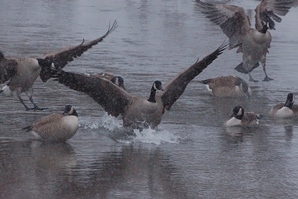The Canada goose: Migratory Bird Treaty Centennial featured bird
Dec. 2, 2016
 Perhaps one of the most recognizable birds in Michigan is the large, regal-looking Canada goose. Once a rare sight in Michigan, Canada geese are now very plentiful in the state. Perhaps one of the most recognizable birds in Michigan is the large, regal-looking Canada goose. Once a rare sight in Michigan, Canada geese are now very plentiful in the state.
With black heads, beaks and necks, grey-brown bodies and a white chin strap, these birds can weigh between 5 and 14 pounds. The female Canada goose is slightly smaller than the male and weighs as much as 12 pounds.
The subspecies of goose that is most plentiful in Michigan is the giant Canada Goose or Branta canadensis maxima. Other subspecies of Canada goose pass through the state during spring and fall migration, but the giant subspecies is the only one that breeds in Michigan.
Geese are herbivores and prefer grass shoots, aquatic vegetation, seed heads and various grains. They will also feed in shallow water by tipping up and reaching into the water for aquatic roots and tubers.
Canada geese usually nest in March and April. The female lays three to eight eggs and incubates them for 25-28 days. Downy goslings can walk and follow their parents shortly after hatching. The youngsters grow quickly and acquire their adult plumage at about four months of age. The young birds stay with the adults for almost a year after hatching.
Adult Canada geese have very few predators, though raccoons, skunks, fox and crows sometimes prey on their eggs.
Because Canada geese are so plentiful, many would never suspect that the giant Canada goose subspecies was believed to be extinct in the 1950s. This subspecies was nearly extinct due to the effects of unregulated overhunting and wetland habitat loss.
By 1920, however, waterfowl enthusiasts had located a small population of giant Canada geese in Rochester, Minnesota. The Michigan Department of Conservation – now the Department of Natural Resources – raised geese at the Mason State Game Farm. Between 1928 and 1964, the DNR released 2,500 geese on 30 sites. That resulted in 14 breeding areas by 1969, with an estimated population of 9,400 birds.
In recent years, the giant Canada goose has experienced population explosions in areas throughout North America. This trend is due in part to the success of wildlife management programs and the adaptability of these magnificent birds.
In Michigan, the number of giant Canada geese counted each spring numbers over 300,000 today. They nest in every Michigan county, but are most common (78 percent of population) in the southern third of the state.
In general, geese have benefited from the way humans have altered the landscape. Canada geese are attracted to areas that provide food, water and protection. Urban areas with lakes and ponds offer all the resources that geese need to survive. During the summer months, Canada geese can be a problem for some property owners.
Goose hunting in Michigan helps to keep goose populations in check. Michigan regularly ranks in the top three states in the nation for Canada goose hunters and harvest. The plentiful geese provide excellent opportunities for goose hunters.
Many of Michigan’s Canada geese migrate south in the winter in large V-shaped flocks. In the southern third of the state, some Canada geese remain all winter, feeding on waste grain in agricultural fields and aquatic vegetation on open waterways.
The Canada goose is protected under the Migratory Bird Treaty Act. The year 2016 marks the centennial of the Convention between the United States and Great Britain (for Canada) for the Protection of Migratory Birds (also called the Migratory Bird Treaty), signed on Aug. 16, 1916. Three other treaties were signed shortly thereafter with Japan, Russia and Mexico. The Migratory Bird Treaty, the three other treaties signed later, and the Migratory Bird Treaty Act form the cornerstones of efforts to conserve birds that migrate across international borders.
The 2016 Migratory Bird Treaty Centennial celebration has included monthly featured bird stories to our DNR Wildlife Viewing email subscribers, celebration events including a weekend of bird-based programming at state parks and visitor centers in June of 2016, and an education program for schools and conservation groups, and more.
To learn more about the Migratory Bird Treaty Centennial, visit www.fws.gov/birds/MBTreaty100. To sign up for DNR Wildlife Viewing emails, visit www.michigan.gov/dnr and click on the red envelope.
/Editors’ note: Contact – Holly Vaughn, 313-396-6863. An accompanying photo is available below for download. Suggested caption:
Giant Canada geese were once thought to be extinct, but today are very plentiful around Michigan./
The Michigan Department of Natural Resources is committed to the conservation, protection, management, use and enjoyment of the state’s natural and cultural resources for current and future generations. For more information, go to www.michigan.gov/dnr.
|

 Perhaps one of the most recognizable birds in Michigan is the large, regal-looking Canada goose. Once a rare sight in Michigan, Canada geese are now very plentiful in the state.
Perhaps one of the most recognizable birds in Michigan is the large, regal-looking Canada goose. Once a rare sight in Michigan, Canada geese are now very plentiful in the state. 




